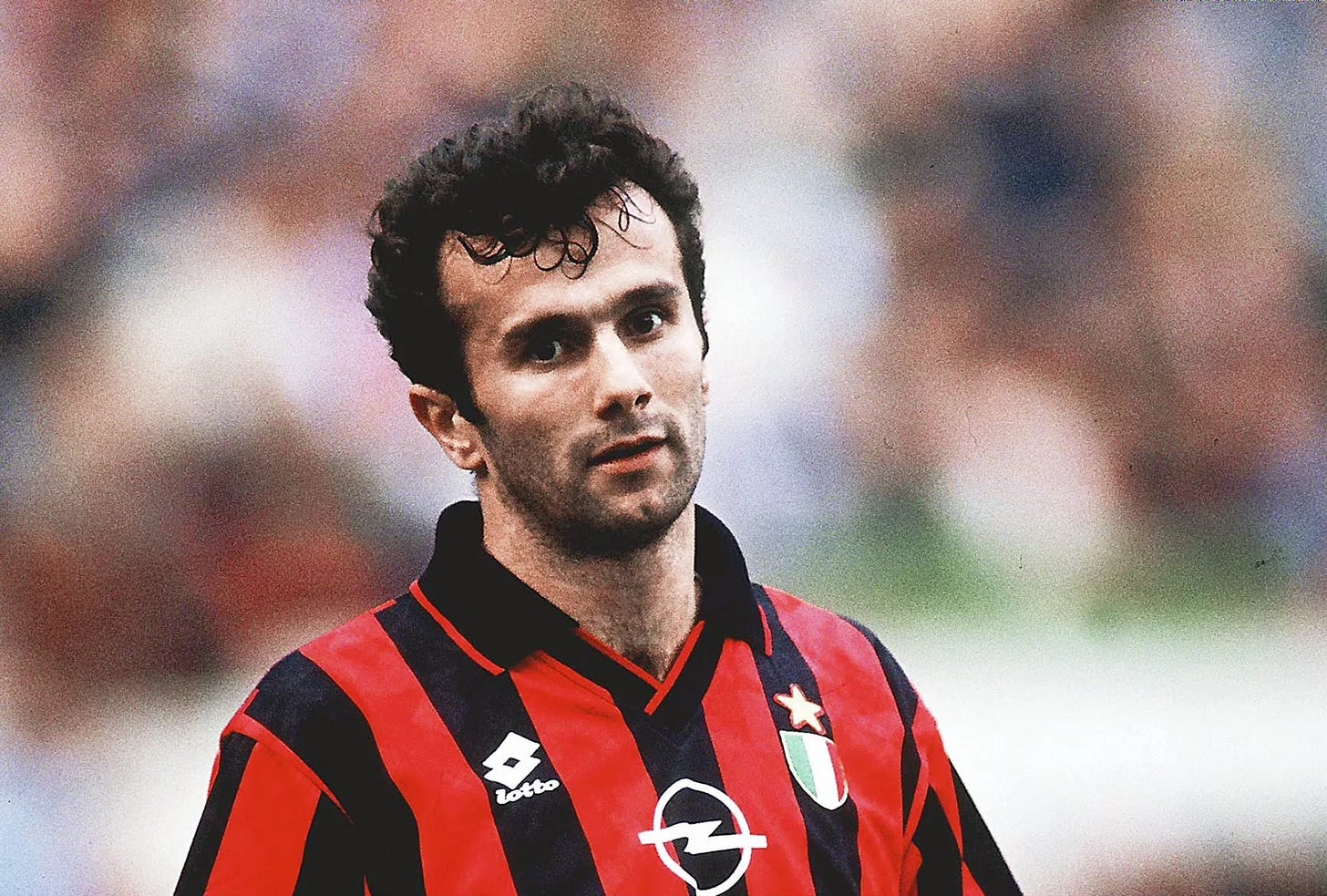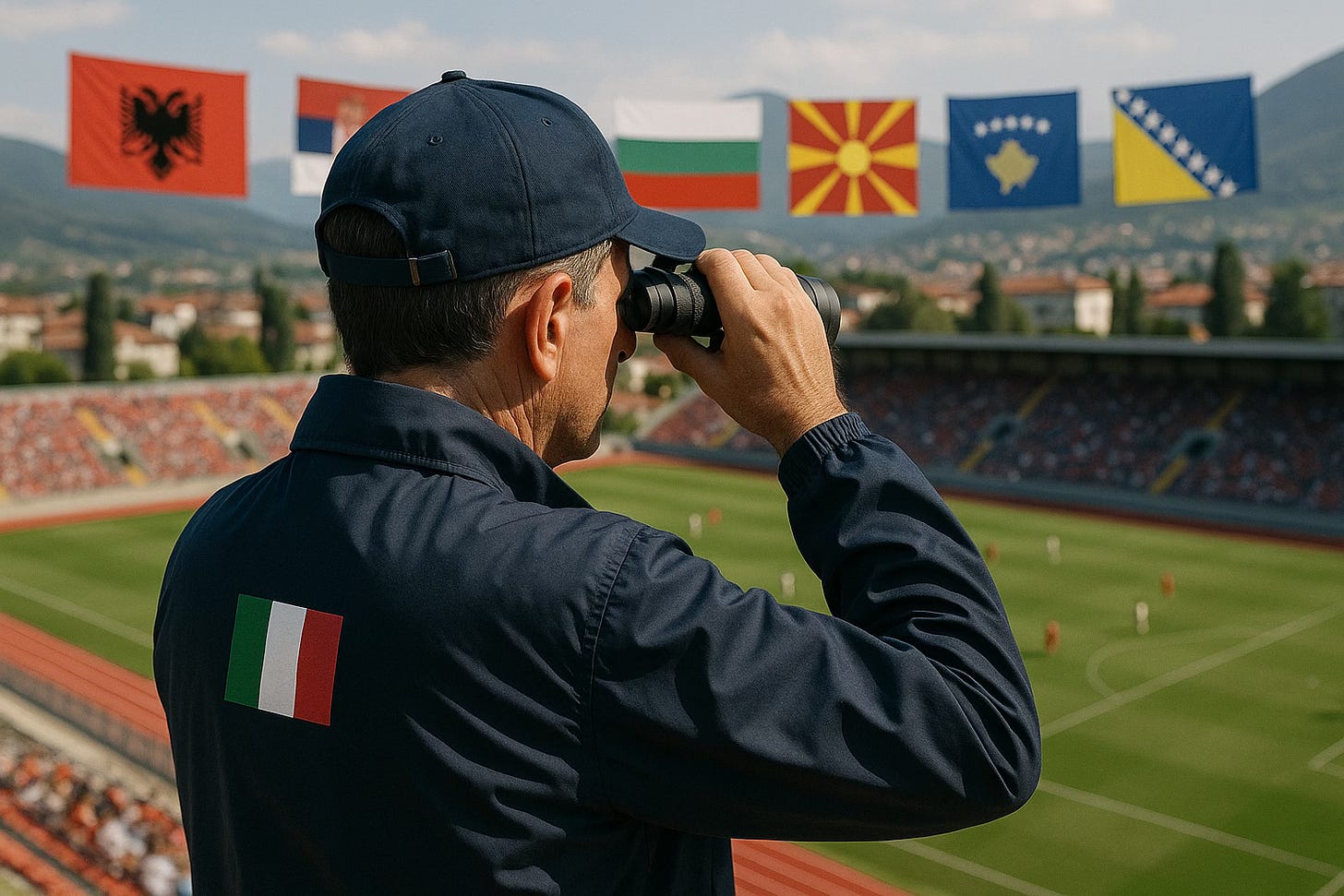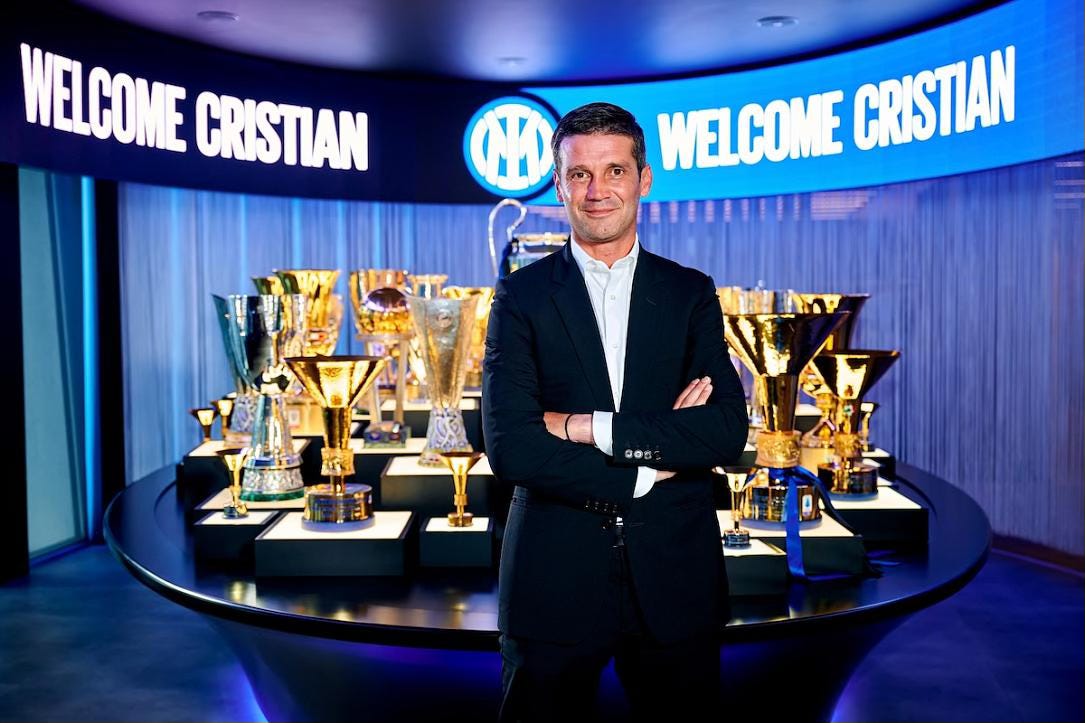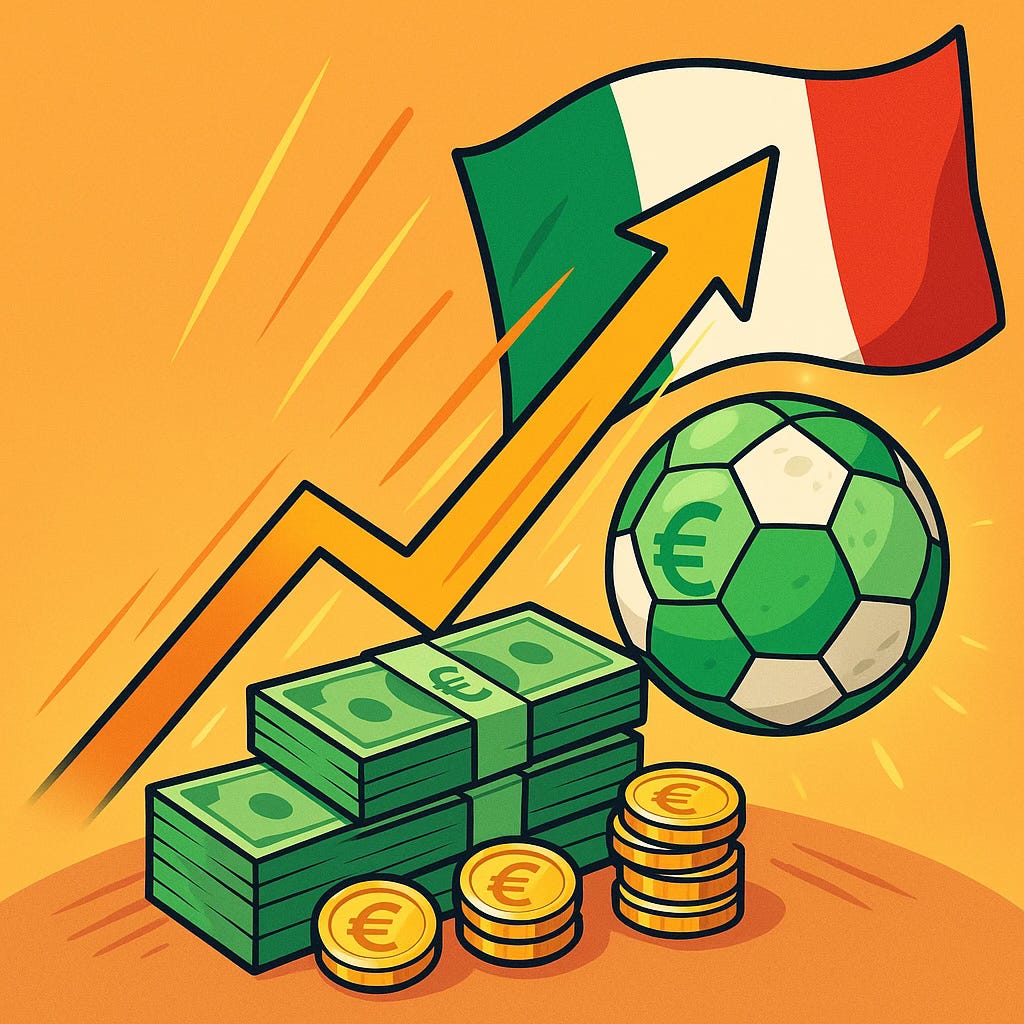Serie A’s Balkan Connection
Exploring Italy's ties to the Balkan region, a successful proving ground for players imported into the Serie A, elevating Italian teams and aiding them to be competitive with the best teams in Europe.
Serie A has long enjoyed a special connection with the Balkans, recruiting an outsized share of players from Southeastern Europe. In fact, Italian clubs rely on Balkan talent more than any other top league, as of 2024 there were 82 players from the region in Serie A, more than double the number in any other “Big Five” league and over four times as many as in England. This article explores how and why this Balkan pipeline developed, notable examples past and present, and whether the trend is set to continue.
Historical Roots
Serie A’s affinity with Balkan players traces back to the early 1990s, when the breakup of Yugoslavia unleashed a wave of talent. After Red Star Belgrade’s European Cup triumph in 1991, many of that team’s stars headed to Italy. Dejan Savićević (Montenegro) signed for AC Milan, Siniša Mihajlović (Serbia) went to Roma, Darko Pančev (North Macedonia) to Inter, and Vladimir Jugović (Serbia) to Sampdoria . Around the same time, other Balkan born talents like Zvonimir Boban (Croatia, AC Milan) and Alen Bokšić (Croatia, Lazio/Juventus) also exceeded expectations in Serie A. Their success opened a pathway to Italian eyes, as to the technical skill and creativity associated with players from the former Yugoslavia.

Throughout the 1990s and 2000s, Italian clubs continued to import top Balkan players. Montenegrin playmaker Dejan Savićević became a Milan fan favourite, Croatian midfielder Zvonimir Boban starred in Milan’s golden era. Lazio’s Scudetto winning side featured Mihajlović and later Dejan Stanković (Serbia), who would go on to win the treble at Inter. Inter and Lazio in particular cultivated a strong Balkan core: Stanković and Mihajlović starred under Roberto Mancini at both clubs. Fiorentina also invested heavily in the Balkans, pairing Stevan Jovetić (Montenegro) and Adem Ljajić (Serbia) in attack in the late 2000s. Even beyond the former Yugoslavia, nearly every Balkan country had representation in Serie A’s golden era, from Bulgarian legend Hristo Stoichkov’s stint at Parma to Romanian stars like Adrian Mutu and Cristian Chivu shining at clubs like Juventus, Fiorentina and Inter.
By the mid-2010s, observers noted that Italy had “the strongest contingent of Balkan players in Serie A ever”. Inter’s 2015–16 squad under Mancini, for example, featured Samir Handanović (Slovenia) in goal, Marcelo Brozović and Ivan Perišić (Croatia) in midfield, Ljajić and Jovetić up front. Fiorentina at the same time relied on Josip Iličić (Slovenia) and Nikola Kalinić (Croatia) for goals. Lazio’s Balkan players included Sergej Milinković-Savić (Serbia), Dušan Basta (Serbia), Senad Lulić (Bosnia) and others. Across town, Roma boasted Bosnian playmaker Miralem Pjanić and striker Edin Džeko. Even Juventus and Napoli, the top two teams of that era, counted a Balkan starter each, Mario Mandžukić (Croatia) leading Juve’s line and Elseid Hysaj (Albania) a fixture in Napoli’s defence. It’s clear that by the 2010s, Balkan players were fundamental across Serie A, from title contenders to mid-table sides.
Why Italian Clubs Scout the Balkans: Value, Culture and Connections
Why does Serie A tap the Balkan market more than other big leagues? A key reason is the financial side. As Italy’s relative spending power declined in the 2010s versus leagues like the Premier League, clubs had to find affordable talent elsewhere. Eastern European and Balkan leagues have struggled financially and their clubs often must sell rising stars at modest prices. Italian scouts know they can “buy good players for reasonable money” by looking east. Wages for players from Serbia, Croatia, etc., are also lower than for equivalent Western European or South American players, making them attractive in a cost conscious league.
Cultural factors play a role too. Many Balkan players adapt well to Italian football, arguably better than to England or other climates . The geographical proximity and lifestyle, including diet, weather, and a passionate football fan culture make Italy a comfortable destination. There is also a shared tactical understanding; historically, coaches in the former Yugoslavia and Romania were influenced by Italian football, so players from those systems adjust quickly to Serie A’s style of play. This was likely due to the popularity of Italian football before the turn of the century.
Another factor is relationship networks and scouting connections. Italian clubs have built ties in the region. Serie A’s recruitment often thrives on “relationship building and establishing ties”. A famous example is Pantaleo Corvino at Fiorentina (now Lecce): during his tenure as Viola sporting director, Corvino had an excellent relationship with Belgrade based agent Fali Ramadani. This pipeline with Ramadani saw Fiorentina sign a raft of Balkan stars such as Stevan Jovetić, Adem Ljajić, Matija Nastasić, Nikola Kalinić, Nikola Milenković mostly from Serbian club Partizan. The club developed and eventually sold many of these players for big profits (e.g. Jovetić and Nastasić to Manchester City). That same Partizan connection helped Fiorentina land Dušan Vlahović, who was later sold to Juventus for around €80 million. Italian clubs that foster links with agents and academies in the Balkans have gained first pick of emerging talent.
There are also scouts of Balkan origin embedded in Italian football. Take Dritan Dervishi, an Albanian scout who heads recruitment at Hellas Verona. Dervishi was specifically hired “in the role of scout for the Balkans” and helped Verona uncover gems like Marash Kumbulla (Albania) and Amir Rrahmani (Kosovo/Albania), both signed cheap and later sold to Roma and Napoli respectively. He admits that while Verona evaluates players on merit, “it is normal that Albanian players will be looked at more closely because in the end I will always be from that country” . Clubs like Verona and Atalanta, known for savvy scouting, have benefited from having eyes and ears in the Balkans. Atalanta in recent years brought in Berat Djimsiti and Etrit Berisha (both Albanian internationals) and Mario Pašalić (Croatia), among others, turning them into key contributors. In short, Italy’s scouting network in Southeast Europe is well developed with a mix of local expertise, agent partnerships, and frequent talent spotting at youth tournaments.
Finally, Serie A clubs lean on the Balkan market because other traditional pipelines are less available or more saturated. Unlike England (which long drew from Scotland/Ireland) or France (with its ties to Africa), Italy lacks a large pool of same language feeder leagues. Historically Italy did tap into South America (thanks to cultural links with Brazil and particularly Argentina through historical migration), but South American wonderkids now command exorbitant fees. Especially since Brazil has began to monopolise the market, as can be demonstrated with their success in the Copa Libertadores. The Balkans thus represent an underserved market where Italian clubs can still find value. As a Juventus executive once noted, every top league has its “small league” to recruit from, and for Serie A the Balkans have become that talent source.
Every Corner of the Balkans Represented
One striking aspect of this trend is how players from virtually every Balkan nation have made their mark in Serie A. From established stars to youth prospects, Italian squads are dotted with names from across Southeastern Europe:
Croatia: A steady producer of Serie A talent. In recent years, Marcelo Brozović and Ivan Perišić were linchpins of Inter’s 2021 title winning side, while striker Mario Mandžukić won multiple Scudetti at Juventus. Historically, AC Milan’s legend Zvonimir Boban and defender Dario Šimić were Croatian trailblazers. Today, rising Croat star Martin Baturina has even attracted Italian interest .
Serbia: Serbian players have been abundant in Italy. Sergej Milinković-Savić became a midfield superstar at Lazio, and Dušan Vlahović emerged at Fiorentina before Juventus paid big money for him. In the past, Dejan Stanković and Sinisa Mihajlović set the standard at Inter and Lazio. Serie A also recruits Serbian youth: AC Milan signed 18-year-old forward Marko Lazetić in 2022, and Juventus snapped up defender Strahinja Pavlović (now at Salzburg) early in his career. The pipeline from Serbian clubs like Partizan and Red Star Belgrade to Italy remains very active.
Slovenia: A smaller nation albeit growing football nation with notable contributions. Samir Handanović and Josip Iličić are Slovenians who became household names in Serie A. In the 1990s, midfielder Srečko Katanec was part of Sampdoria’s Scudetto winning squad. Such successes have made Slovenian prospects attractive to Italian scouts.
Bosnia and Herzegovina: Bosnian players have flourished in Italy, often via other leagues. Miralem Pjanić developed at Lyon but became a star playmaker at Roma and Juventus. Striker Edin Džeko, after success in Germany and England, joined Roma and later Inter, continuing to score prolifically into his mid-30s. The versatile Senad Lulić was a fan favourite at Lazio for a decade. Bosnian talent has an easy path to Italy in part due to shared language with Serbo-Croatian-speaking scouts and agents.
Montenegro: Despite a small population, Montenegro has punched above its weight in Italy. Stevan Jovetić made a name at Fiorentina as a teenager. Mirko Vučinić spent a decade in Serie A starring for Lecce, Roma, and Juventus. Defender Stefan Savić had a stint at Fiorentina before moving to La Liga. Montenegrins’ impact can be traced back to the Yugoslav era, the great Dejan Savićević at Milan.
North Macedonia: The country’s most iconic player, Goran Pandev, spent virtually his entire career in Italy, winning the Champions League with Inter in 2010 and scoring over 100 Serie A goals across Lazio, Napoli and Genoa. More recently, young midfielder Elif Elmas moved to Napoli in 2019 and has been developing into a key contributor. North Macedonian youth prospects (like those from the Balkans generally) often view Serie A as an ideal next step.
Albania & Kosovo: Albanian players have become particularly prominent in Serie A in the last decade. Elseid Hysaj was a key full-back under Maurizio Sarri at both Empoli and Napoli. Berat Djimsiti anchors Atalanta’s defence, while goalkeeper Etrit Berisha had many years in Italy. Kosovo born Amir Rrahmani captained his country and became a Serie A champion with Napoli in 2023. Albanian talent has also flowed into Italian youth teams, e.g. Inter signed midfielder Kristjan Asllani (Italian raised Albanian) and Empoli developed him into a Serie A regular. With a strong Albanian contingent in Italy and scouts like Dervishi, this pipeline is strong and likely to grow.
Greece: Greek internationals have found their way to Serie A as well. Centre-back Kostas Manolas became one of Serie A’s top defenders at Roma and Napoli. His compatriot Sokratis Papastathopoulos had a spell at AC Milan early in his career. In past years, Georgios Karagounis featured at Inter, and more recently young Greek goalkeeper Orestis Karnezis was signed by Udinese and Napoli. While Greece isn’t always counted as “Balkan” in a narrow sense, its players are very much part of this regional exchange with Italy.
Romania: Italy’s connection with Romanian players dates back to the 1990s, when Gheorghe Hagi and Florin Răducioiu had short stints in Serie A. The link deepened in the 2000s with stars like Adrian Mutu (Parma, Fiorentina) and Cristian Chivu (Roma, Inter) becoming key figures. Perhaps the most loyal servant is Ștefan Radu, who joined Lazio in 2008 and amassed over 400 appearances. This is a testament to how well Romanians can adapt in Serie A. In recent years, Juventus even brought in Romanian teenager Radu Drăgușin, developing him through their U23 side. Several other Romanian prospects have followed, drawn by Italy’s competitive primavera (youth) system.
My Romanian friends also ensure me that the Italian and Romanian languages are somewhat similar. Both being classed as a Romance language, with Romanian being unlike other “Slavic” languages. This could play a key part in players quickly integrating.Bulgaria: Bulgarian stars in Serie A have been fewer, but still significant. The legendary Hristo Stoichkov came to Parma in 1995 after his Barcelona exploits. In the 2000s, Valeri Bojinov emerged as a teenage sensation at Lecce, and later played for Juventus and others. More recently, Kiril Despodov (Currently at Greek giant PAOK), Bulgaria’s Player of the Year in 2018, earned a transfer to Cagliari in 2019 (Cagliari reportedly paid around €4.2 million for him, a Bulgarian league record fee at the time). Defender Valentin Antov, captain of CSKA Sofia as a youngster, was snapped up on loan by Bologna in 2021 to test his mettle abroad. While Bulgarian players haven’t been as numerous in Serie A, the league is clearly viewed as an attractive stepping stone for Bulgaria’s top talents as well.
It’s worth noting that even at the youth level, Serie A clubs are investing in the Balkans. Juventus, for example, signed 17-year-old Montenegrin forward Vasilije Adžić in 2023 and put him straight into their Next Gen (reserve) team, where he impressed so much that he quickly earned first-team opportunities. AC Milan added Serbian defender Jan-Carlo Šimić and Bosnian-born talent Andrej Živković (while promoting homegrown Croatian-Italian midfielder Marko Lazetić). Inter brought in teenage prospects like Luka Topalović (from Bosnia’s FK Sarajevo) and even lured a 15-year-old Bulgarian, Nikola Iliev, ahead of Ajax as a future project. This broad based recruitment shows that Italian clubs plan for the long term with Balkan talent, integrating them early so they count as “homegrown” under league rules. It’s a cycle young players see a clear pathway in Italy, which encourages more to come.
The Financial Edge
Importing players from the Balkans has proven to be a cost effective strategy that levels the playing field for Italian clubs. As Serie A struggles to match the spending of England, Germany or Spain, mid-table Italian clubs will continue to use the Balkan market for high potential bargains with resell value. It’s not just the smaller clubs, even giants like Juventus and Inter, constrained by budgets (relative to other top 5 leagues), are investing in promising youth from the region rather than splashing tens of millions on fully developed stars. The market prices in Serbia, Croatia, and so on remain relatively low, and clubs there often need to sell their assets to survive. This creates an opportunity that Italian sides are keen to seize. “As most Serbian and Croatian clubs are struggling for money, they need to generate funds through selling players, and we can safely expect this to continue over the coming seasons,” one expert observed . In other words, the talent pipeline from the Balkans will likely flow for years to come, as both sides benefit: Balkan players get a big league platform, while Italian teams get quality recruits at sensible prices.
Hellas Verona’s scout Dervishi emphasizes character as a key factor, players like Rrahmani and Kumbulla were not just talented but mentally tough and eager to prove themselves. That work ethic, combined with solid fundamental training received in home countries, means many Balkan players over perform relative to their transfer cost. For cash strapped Italian teams, this value for money is indispensable.
In fact, Italy’s top flight might even deepen its Balkan connection. Strong showings by Balkan national teams at Euro 2024 (Slovenia, Albania, Romania and others all impressed on the big stage) have only increased European interest in the region’s talent pool. But no league has been as active in that market as Serie A, a status it has earned through decades of trust and success with Balkan stars. Every top five European league has its favored recruiting grounds (France taps French speaking Africa, Germany looks to Austria/Switzerland usually using them as a proving ground before entering the Bundesliga), and the Balkans have become Serie A’s specialty . The numbers back it up, and the stories of players like Vlahović, Brozović or Kumbulla, plucked from relative obscurity.
Rising Balkan Stars in Serie A Youth Squads
Serie A’s youth academies continue to thrive with Balkan talent. Here’s a look at some promising prospects:
Matteo Duțu
(Romania – AC Milan Youth / Milan Futuro)
Profile: A Romanian centre-back, born in Italy (2005), Duțu rose through Lazio’s youth ranks before moving to AC Milan’s under-19s in July 2024 .
Highlight: He made his professional debut with Milan’s reserve side, Milan Futuro, playing in Serie C in October 2024—and even joining senior squad pre-season tours in 2025 .
Andrei Coubiș
(Romanian heritage – Captain of Milan Futuro)
Profile: Born in Milan in 2003 to Romanian parents, Coubiș is a defender who captains Milan Futuro, AC Milan’s reserve team .
Highlight: He debuted professionally in August 2024 in the Coppa Italia Serie C, and scored his first goal in February 2025. Coubiș also featured in pre-season friendlies with the senior squad under Allegri .
Mate Ivković
(Croatia – Sampdoria Youth)
Profile: A Croatian midfielder born in 2006, Ivković transitioned from Hajduk Split’s academy to Roma’s youth setup in 2022 and transferred to Sampdoria in early 2025 .
Highlight: Regarded as one of Croatia’s brightest midfield prospects, Ivković has already trained with Roma’s first team and was pursued by multiple European clubs before his move .
Sergej Levak
(Croatia – Atalanta U23)
Profile: Born in 2006 in Osijek, Croatia, Levak is a central midfielder who joined Roma’s youth ranks in 2023 before signing with Atalanta, playing for their U23 team in Serie C .
Highlight: His athletic profile, standing at 1.95 m with high technical ability, has drawn comparisons to elite midfielders like Rodri .
Vasilije Adžić
(Montenegro – Juventus Youth)
Profile: An attacking midfielder from Montenegro, Adžić joined Juventus in 2024 from Budućnost Podgorica and is already integrated into their youth setup.
Highlight: Notable within Serie A’s next generation, he has made senior appearances and has been highlighted by youth talent scouts as a potential top Balkan breakout star
Conclusion
From the Yugoslav imports of the 1990s to the 82 strong cohort of Balkan players in Serie A today, the link between Italian football and the Balkan region is stronger than ever. This partnership is built on mutually beneficial Italian clubs gain skilled, motivated players at affordable prices, while Balkan professionals get a stage to develop and win fame. Crucially, the trend has deep roots, a cultural familiarity and footballing respect that has grown over 30 years. Given the economic realities and continued growth in talent, we can confidently say the Balkan imports into Italy will continue.
Sources:
Running the Show Blog – “A Look at Serie A’s Balkan Connection”
Confirms Red Star Belgrade’s 1991 European Cup win and subsequent moves of Dejan Savićević (AC Milan), Darko Pančev (Inter), Siniša Mihajlović (Roma), Vladimir Jugović (Sampdoria), plus Croatian stars Zvonimir Boban (AC Milan) and Alen Bokšić (Lazio/Juventus).
https://runningtheshowblog.wordpress.com/2016/01/27/a-look-at-serie-as-balkan-connection
All Football App – Exclusive Interview: In a March 2023 interview, Dritan Dervishi—Hellas Verona’s head of scouting—said he was brought to Verona by Sogliano “in the role of scout for the Balkans.” He later rose to head the club’s overall scouting operations
Transfermarkt - to look at several transfer fee’s and details
https://www.101greatgoals.com/features/the-quiet-ones-number-1-fk-partizan/
Wikipedia – Dejan Savićević
Details his transfer from Red Star to AC Milan in 1992, Serie A titles, and Champions League victory.
Wikipedia – Darko Pančev
Confirms move to Inter in 1992 after Red Star success.
Wikipedia – Siniša Mihajlović
Confirms 1991 European Cup win with Red Star and Serie A career at Roma, Sampdoria, Lazio, Inter.
Wikipedia – Vladimir Jugović
Confirms stints at Sampdoria, Juventus, Lazio, Inter in the 1990s.
Wikipedia – List of Foreign Serie A Players
Comprehensive list confirming appearances of Balkan stars like Boban, Bokšić, Stanković, Jovetić, Ljajić, Milinković-Savić, Pjanić, Džeko, Mandžukić, Hysaj, and many others across multiple decades.
https://en.wikipedia.org/wiki/List_of_foreign_Serie_A_players
Wikipedia – Adem Ljajić
Confirms January 2010 transfer to Fiorentina from Partizan for around €8 million.







Serie A has always been a home to the best Balkan talents!!! Great piece!!
I wrote about Serie A scouting excellence in Giovanni Sartori, who bought many Balkan players like Ilicic, Djimsiti, and Pasalic. Now at Bologna, he signed Nikola Moro and Martin Erlic.
https://open.substack.com/pub/federicotomadin/p/giovanni-sartori-the-sporting-director?r=4k9oj2&utm_campaign=post&utm_medium=web&showWelcomeOnShare=true